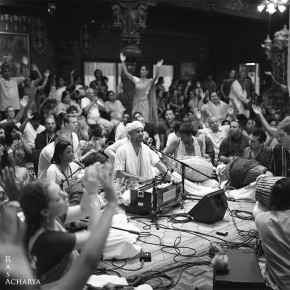 Caitanya and Nityananda, the sixteenth century bhakti saints, who originated the modern-day practice of kirtan.
Caitanya and Nityananda, the sixteenth century bhakti saints, who originated the modern-day practice of kirtan.Kirtan is the art of sacred sound, of connecting to the Divine, to God, through an active meditation on spiritual musical vibrations. The art of kirtan has its origins in the ancient Vedic culture of India, yet kirtan is universal. It is the call of the spirit to the presence and love of God that goes beyond all the boundaries that we can think of.
Kirtan is the foundation of our worship here at The Bhakti Center. It is something we participate in everyday as monks and laypeople in our congregation, and it is the soul of our spiritual life. The art of kirtan, as we practice it in our bhakti tradition. consists of calling out the names of God as presented from our sastra, or sacred scripture. By meditating upon these names of God, we clear the dust of misconception and illusion from our own heart, freeing us to discover our original, natural, spiritual self.
Our chanting is accompanied by traditional instruments such as the mrdanga (a two-headed clay drum originating from India) and the harmonium (an air-pumped keyboard instrument originating from Germany) as well as any number of appropriate modern instrumentation as well.
There are three names of God that we chant in kirtan. We chant Hare (the feminine aspect of the Divine), Krishna (the masculine aspect of the Divine), and Rama (the pleasure potency of the Divine). Combined they form the world-famous Hare Krishna mantra: Hare Krishna/Hare Krishna/Krishna Krishna/Hare Hare/Hare Rama/Hare Rama/Rama Rama/Hare Hare.
 We invite you to join us in our kirtan. It is open for you to participate in as much as your heart desires. We hope you become enlivened and inspired on your own spiritual journey by these sacred sound vibrations.
We invite you to join us in our kirtan. It is open for you to participate in as much as your heart desires. We hope you become enlivened and inspired on your own spiritual journey by these sacred sound vibrations.
No comments:
Post a Comment